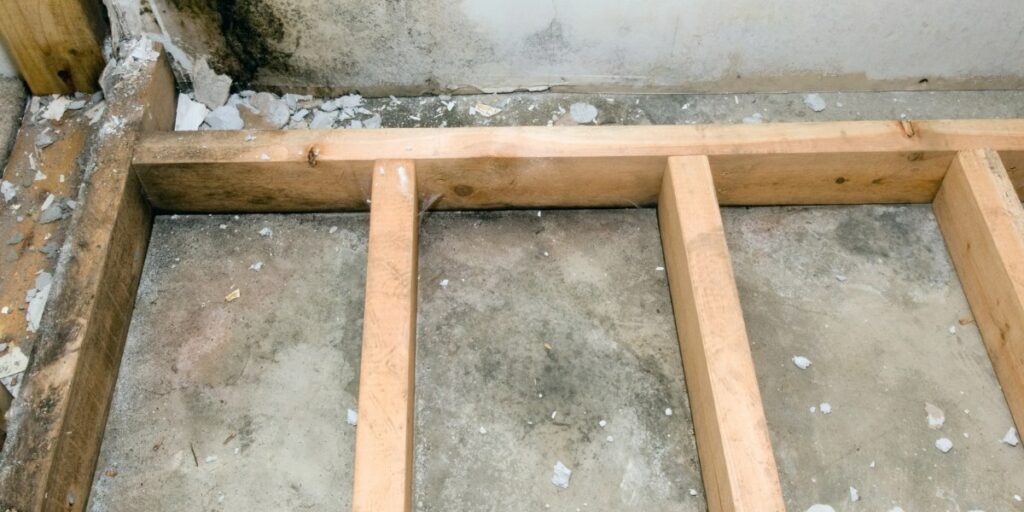Water damage in the basement is a common yet daunting issue many homeowners face. Whether caused by flooding, leaks, or other moisture problems, it’s crucial to address this damage promptly to prevent mold growth and structural issues. This comprehensive guide outlines the steps to effectively clean a basement floor after water damage, ensuring a safe and healthy home environment.
Before diving into the basement cleaning process, assessing the extent of water damage is important. Check for standing water, damp walls, and damaged items. This assessment will help you determine the required tools and approach for cleaning.
Equip yourself with these essential tools:
- Rubber gloves and boots: Protect your hands and feet from debris, bacteria, and potential electrical hazards.
- N95 respirator or mask: Shield yourself from airborne mold spores and other contaminants.
- Flashlight: Illuminate dark corners and hidden dangers in the floodwater.
- Waders or waterproof boots: Stay dry and mobile while navigating the flooded space.
- Heavy-duty trash bags: Discard ruined materials and debris efficiently.
Before starting the cleanup, prioritize safety. Ensure the electricity is turned off in the affected area to prevent electrical hazards.
Step 1: Water Removal
Begin by removing any standing water. Use a pump or a wet-dry vacuum, depending on the water level. Ensure the water is disposed of far from the house to prevent re-entry. Acting quickly to minimize water absorption in floors and walls is essential.
Step 2: Sorting and Disposal
Sort through items in the basement. Salvageable items should be cleaned and dried, while severely damaged items, particularly those made of porous materials, should be discarded to prevent mold growth.
Step 3: Drying the Area
Once the water is removed, focus on drying the area. Use fans and dehumidifiers to accelerate the drying process. Air circulation is key in preventing mold and mildew.
Step 4: Cleaning and Disinfecting
After drying, clean the floors thoroughly. For concrete floors, use a mixture of hot water and heavy-duty cleaner. Scrub the surface with a stiff brush to remove dirt and residue. Use a suitable tile cleaner for tiled floors and avoid harsh chemicals that may damage the grout.
Step 5: Disinfecting
Post-cleaning, it’s crucial to disinfect the area to kill any bacteria and mold spores. Use a solution of one cup of bleach per gallon of water. Apply it to the floor and let it sit for a few minutes before rinsing.
Step 6: Mold Prevention
Mold thrives in damp environments, and flooded basements offer the perfect breeding ground. Be vigilant!

Look for signs of mold growth, such as:
- Visible patches of fuzzy growth, often black, green, or white
- Musty odors
- Allergic reactions, such as sneezing, coughing, and itchy eyes
If you detect mold, act quickly:
- Small areas: Clean them with a diluted bleach solution and a stiff brush.
- Large areas or persistent mold growth: Seek professional mold remediation services.
Take measures to prevent mold growth. Keep the area dry and maintain good ventilation.
Step 7: Basement Restoration and Repairs
Once the cleanup is complete, it’s time to rebuild your basement. Here’s what to consider:
- Structural repairs: If the flood caused any structural damage, address it immediately with the help of qualified professionals. This might involve repairing cracks, reinforcing walls, or replacing damaged foundations.
- Electrical repairs: Flooded electrical systems pose a serious hazard. Have a licensed electrician inspect and repair any damaged wiring before turning on the power again.
- HVAC system maintenance: Floodwater can damage your HVAC system. Have it inspected and serviced to ensure the proper functioning and prevent future problems?
- Flooring and walls: Depending on the damage, you might need to replace carpet, refinish hardwood floors, or repaint walls. Choose moisture-resistant materials for future protection.
- Basement waterproofing: Consider investing in solutions like sump pumps, drainage systems, and sealants to prevent future flooding.
- Dehumidification and ventilation: Installing a dehumidifier and improving ventilation can help maintain a dry environment and prevent future mold growth.
- Insurance claims: If your basement flooding is covered by insurance, document the damage thoroughly and file a claim promptly.
Remember, you don’t have to go through this alone. If the task seems overwhelming or you suspect potential health hazards, consider hiring professional cleaning and restoration services. They have the expertise and equipment to handle complex cleanup tasks and ensure your basement’s safety and health.
What can you do to prevent basement flooding?
Once your basement is restored, take steps to prevent future flooding:
- Regularly inspect and clean gutters and downspouts.
- Seal cracks and entry points around windows and doors.
- Install backup sump pumps and flood alarms.
- Elevate appliances and furniture on platforms.
- Monitor weather forecasts and take precautions during heavy rain.
Cleaning up a flooded basement is daunting, but with the right knowledge, preparation, and determination, you can reclaim your space and restore it to its former glory. Remember, safety is paramount, so prioritize personal protection, and don’t hesitate to seek professional help if needed.
Following these steps and taking proactive measures can prevent future flooding and allow you to enjoy a dry, healthy, and comfortable basement for years.

